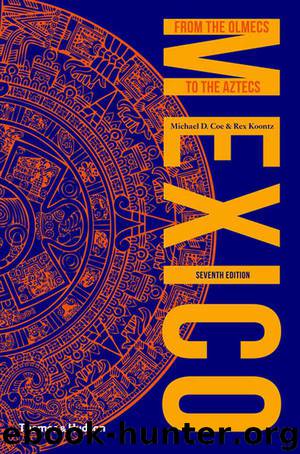Mexico: From the Olmecs to the Aztecs (Ancient Peoples and Places) by Michael D. Coe & Rex Koontz

Author:Michael D. Coe & Rex Koontz [Coe, Michael D.]
Language: eng
Format: epub
Publisher: Thames & Hudson
Published: 2013-06-14T00:00:00+00:00
104 God L, the Maya god of merchants, from a mural at Cacaxtla, Tlaxcala. He is here given the non-Maya name “4 Dog.” To the right is his cacaxtli or back-pack; attached to it is his headdress.
105 South Mural at Cacaxtla, Tlaxcala. The figure wears eagle costume and feet, and stands on a feathered serpent. Aquatic animals and stylized maize plants frame the scene. Epiclassic period.
The Cacaxtla murals are thoroughly Maya in their style. Both the naturalistic body proportions and the organic, flowing profiles are diagnostic of the Epiclassic Maya painting tradition and contrast with the more blocky, geometric style of Teotihuacan and much of the rest of highland Mexico. Figural poses also strongly recall Maya models: particularly striking are the figures holding Maya-derived “ceremonial bars,” either of whom might be at home on the reliefs of Seibal, an important center on the Río Pasión in the southern Maya lowlands which was deeply involved in Epiclassic disruptions of the political landscape. Also telling is the use of a vegetable binder to form the paint medium – a technique defined by art historian Diana Magaloni for Maya and Gulf Coast mural artists, but unknown in central Mexico, where pigments diluted with water were laid on fresh plaster in the true fresco technique. At the same time, the writing that accompanies these images is not Maya but a hybrid of earlier Teotihuacan and Oaxacan scripts along with innovative elements, the whole used mainly to designate the names of key figures. Certainly the main audience was not Maya lords, but central Mexican elites. Except for these important artistic characteristics, there is little in the cultural record of Cacaxtla that indicates a larger Maya presence, suggesting that these traits were imported by an intermediate group like the Olmeca-Xicallanca, who would have acquired such traits in their southern Gulf Coast homeland, immediately adjacent to the Maya area.
Equally intriguing is the presence of a large number of female figurines in an offering found in the nearby site of Xochitecatl, many of which share important elements with southern Gulf Coast female figures. Xochitecatl, which had an important Preclassic occupation, was reinhabited during the Epiclassic when the female figures were deposited and the major pyramid aligned to the Cacaxtla palace, suggesting that the ceremonial center was controlled by the Cacaxtla elites. The group of figures with raised hands, filed teeth, and pronounced smiles share these traits with figures on the Gulf Coast, although the slab-like bodies at Xochitecatl follow local practices. Archaeologist Mari Carmen Serra and her team have identified numerous ritual and political offices for the female figures, which along with the female dress of several Cacaxtla battle figures point up the important role of females and gender symbolism at these closely related sites, a trait shared with Epiclassic southern Veracruz, especially at sites like El Zapotal. At nearby Cholula, Epiclassic peoples constructed a monumental plaza abutting the Great Pyramid that contained scroll-style carvings reminiscent of Gulf Coast yokes and other stone sculpture. May we associate these
Download
This site does not store any files on its server. We only index and link to content provided by other sites. Please contact the content providers to delete copyright contents if any and email us, we'll remove relevant links or contents immediately.
| Africa | Americas |
| Arctic & Antarctica | Asia |
| Australia & Oceania | Europe |
| Middle East | Russia |
| United States | World |
| Ancient Civilizations | Military |
| Historical Study & Educational Resources |
The Daily Stoic by Holiday Ryan & Hanselman Stephen(2703)
The Fate of Rome: Climate, Disease, and the End of an Empire (The Princeton History of the Ancient World) by Kyle Harper(2429)
People of the Earth: An Introduction to World Prehistory by Dr. Brian Fagan & Nadia Durrani(2345)
Ancient Worlds by Michael Scott(2098)
Babylon's Ark by Lawrence Anthony(2065)
Foreign Devils on the Silk Road: The Search for the Lost Treasures of Central Asia by Peter Hopkirk(2050)
India's Ancient Past by R.S. Sharma(1982)
MOSES THE EGYPTIAN by Jan Assmann(1968)
The Complete Dead Sea Scrolls in English (7th Edition) (Penguin Classics) by Geza Vermes(1835)
Lost Technologies of Ancient Egypt by Christopher Dunn(1796)
The Daily Stoic by Ryan Holiday & Stephen Hanselman(1764)
The Earth Chronicles Handbook by Zecharia Sitchin(1742)
24 Hours in Ancient Rome by Philip Matyszak(1675)
Alexander the Great by Philip Freeman(1642)
Aztec by Gary Jennings(1539)
The Nine Waves of Creation by Carl Johan Calleman(1518)
Curse Tablets and Binding Spells from the Ancient World by Gager John G.;(1509)
Before Atlantis by Frank Joseph(1481)
Earthmare: The Lost Book of Wars by Cergat(1465)
